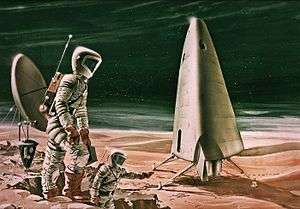Mars Excursion Module

The Mars Excursion Module (MEM) was a spacecraft proposed by NASA in the 1960s for use in a manned mission to Mars. It formed part of Mars orbit rendezvous (MOR) and flyby-rendezvous mission profiles studied at NASA's Manned Spacecraft Center in the 1960s.[1] The Mars Excursion Module would have been a combination of a Mars lander, short-stay surface habitat, and ascent vehicle; the ascent stage performed the rendezvous. The MEM would have been used for a 40-day stay on the Martian surface in the flyby-rendezvous mission profile or for a 10- to 40-day stay in the MOR profiles.[1]
In 1964, Philco Aeronutronic proposed a lifting body MEM, approximately 30 feet (9.1 m) long and 33 feet (10 m) wide at the tail, which would carry three astronauts. The hull would have consisted of columbium and nickel alloy. The MEM's descent stage would have served as the launch pad for liftoff of the ascent stage, as with the Apollo Lunar Module.[1]
A Mars Excursion Module was discussed as a possibility in the Space Task Group Report of 1969, with a development decision required in FY 1974 for a 1981 Mars mission or in FY 1978 for a 1986 mission.[2]
In popular culture
"One Way To The Moon", a 1966 episode of The Time Tunnel, featured a Mars Excursion Module launched in 1978.[3] Mars Excursion Modules are also featured in Stephen Baxter's novel Voyage, an alternate history of space exploration in which NASA astronauts land on Mars in 1986 in a MEM named Challenger.[4]
References
- 1 2 3 Portree, David S. F. (February 2001). "Chapter 3: EMPIRE and After". Humans to Mars: Fifty Years of Mission Planning, 1950 - 2000 (PDF). NASA Monographs in Aerospace History Series. National Aeronautics and Space Administration. pp. 15–18. Retrieved July 18, 2014.
- ↑ "Report of the Space Task Group, 1969". NASA. September 1969. Retrieved July 10, 2014.
- ↑ Welch, William (September 16, 1966). "One Way To The Moon". The Time Tunnel. Season 1. Episode 2. American Broadcasting Company.
- ↑ Baxter, Stephen (1996). Voyage. New York, N.Y.: HarperPrism. ISBN 0-06-105258-2.